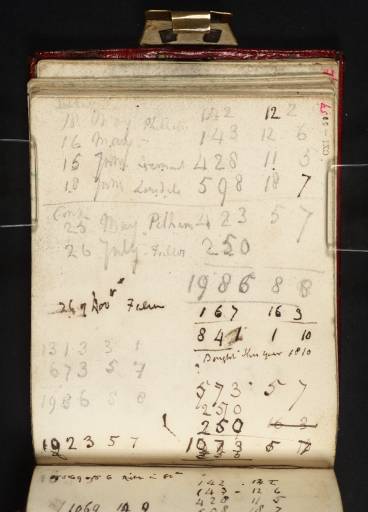Joseph Mallord William Turner Accounts (Inscriptions by Turner) 1810
Joseph Mallord William Turner,
Accounts (Inscriptions by Turner)
1810
Folio 59 Recto:
Accounts (Inscriptions by Turner) 1810
D07686
Turner Bequest CXI 59
Turner Bequest CXI 59
Pencil and pen and ink on white wove paper, 110 x 88 mm
Inscribed by Turner in pencil and ink (see main catalogue entry)
Inscribed by John Ruskin in red ink ‘59’ top right, running vertically
Stamped in black ‘CXI 59’ top right, running vertically
Inscribed by Turner in pencil and ink (see main catalogue entry)
Inscribed by John Ruskin in red ink ‘59’ top right, running vertically
Stamped in black ‘CXI 59’ top right, running vertically
Accepted by the nation as part of the Turner Bequest 1856
References
1909
A.J. Finberg, A Complete Inventory of the Drawings of the Turner Bequest, London 1909, vol.I, p.299, CXI 59.
1984
Martin Butlin and Evelyn Joll, The Paintings of J.M.W. Turner, revised ed., New Haven and London 1984, pp.75, 77, 129, 130.
1990
Eric Shanes, Turner’s England 1810–38, London 1990, pp.8, 278 note 10.
1998
James Hamilton, Turner: A Life, London 1998, pp.140–1.
2001
Evelyn Joll, ‘Lonsdale, Earl of (1757–1844)’, in Evelyn Joll, Martin Butlin and Luke Herrmann eds., The Oxford Companion to J.M.W. Turner, Oxford 2001, p.178.
2002
Ian Warrell, ‘Petworth Revisited: Turner’s Paintings for the Carved Room and his Other Country House Subjects’, in Christopher Rowell, Ian Warrell and David Blayney Brown, Turner at Petworth, exhibition catalogue, Petworth 2002, p.51.
Turner’s inscription, in pencil and ink, reads:
18 May 142. 12. 2
Phillips
143. 12. 6
15 June Egremont 428. 11. 5
18 June Lonsdale 598. 18. 7
Cons.
25 May Pelham 423. 5. 7
16 July Fuller 250.
1986. 8. 8
26 of Nov. Fuller 167. 16. 3
841. 1. 10
Bought this year 1810.
1313. 3. 1.
673. 5. 7 573. 5 7
1986. 8. 8 250
250
1073. 5. 7
1923. 5. 7 50
Phillips
143. 12. 6
15 June Egremont 428. 11. 5
18 June Lonsdale 598. 18. 7
Cons.
25 May Pelham 423. 5. 7
16 July Fuller 250.
1986. 8. 8
26 of Nov. Fuller 167. 16. 3
841. 1. 10
Bought this year 1810.
1313. 3. 1.
673. 5. 7 573. 5 7
1986. 8. 8 250
250
1073. 5. 7
1923. 5. 7 50
Totting up his income (or expenditure against it; see below) from the sale of pictures in 1810 Turner lists purchasers and patrons. Sir George Phillips commissioned Linlithgow Palace, Scotland (Walker Art Gallery, Liverpool),1 shown at Turner’s Gallery that year. Butlin and Joll observe that its likely price was 200 guineas and inside the front cover of the sketchbook (D07594) Turner notes ‘Money received of Phillips 210’, the equivalent in pounds sterling.
The Earl of Egremont’s payment is for Petworth, Sussex, the Seat of the Earl of Egremont: Dewy Morning2 and Cockermouth Castle3 (Tate T03880, T03879; both displayed at Petworth House), commissioned in 1809 and in Turner’s Gallery in 1810. According to Finberg, the former cost 200 guineas and the latter 100 guineas.4
The Earl of Lonsdale features for his two pictures of Lowther Castle at mid-day5 and evening6 (private collection), in the Royal Academy in 1810. Again the sum given is too large for two pictures of Turner’s usual 200 guinea size which has led to speculation that he charged extra for some drawings of Whitehaven, perhaps even an entire sketchbook, dating from his Cumbrian tour in 1809.7 But see comments below on price differences.
The Hon. Charles Pelham, later 1st Earl of Yarborough, bought The Wreck of a Transport Ship (Fundaçao Calouste Gulbenkian, Lisbon)8 in 1810. Butlin and Joll state that it cost 300 guineas, noting the disparity with the 400 paid by the same family in 1804 for a canvas of the same large size.9 See also folio 60 of this sketchbook (D07688) where the same sum of £423. 5. 7 is given.
The other transactions involve John Fuller who bought Fishmarket on the Sands (William Rockhill Nelson Gallery and Atkins Museum of Fine Arts, Kansas City, Missouri)10 from Turner’s Gallery in 1810 and commissioned Rosehill Park, Sussex (private collection)11 the same year. Around the same time, Turner also made a set of four views in East Sussex to hire out to Fuller for reproduction in aquatints for presentation to his friends and neighbours. In due course, Fuller bought them and added others to his collection.12
Differences between the standard prices of Turner’s pictures and actual receipts or costs can be accounted for by translation from guineas to pounds and surcharges for framing, packing or delivery,13 which could be substantial. Some of these figures are repeated in accounts of transactions with Turner’s stockbroker, William Marsh, in the Finance sketchbook (Tate D08283–D08359; D40898–D40901; D41431; Turner Bequest CXXII). As explained by Finberg,14 Turner handed money received from his clients to Marsh to use to buy stocks, which he sold when he needed cash.
David Blayney Brown
April 2011
Alexander J. Finberg, The Life of J.M.W. Turner, R.A. Second Edition, Revised, with a Supplement, by Hilda F. Finberg, revised ed., Oxford 1961, p.171.
See notes to the Views in Sussex sketchbook (Tate D10320–D10324; D10326–D10342; D40296–D40298; Turner Bequest CXXXVIII).
How to cite
David Blayney Brown, ‘Accounts (Inscriptions by Turner) 1810’, catalogue entry, April 2011, in David Blayney Brown (ed.), J.M.W. Turner: Sketchbooks, Drawings and Watercolours, Tate Research Publication, December 2012, https://www

